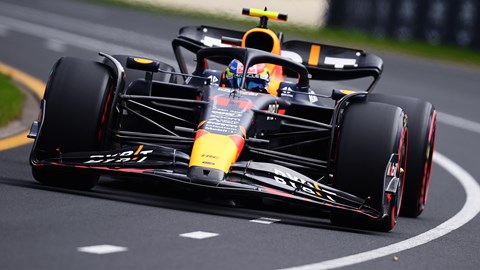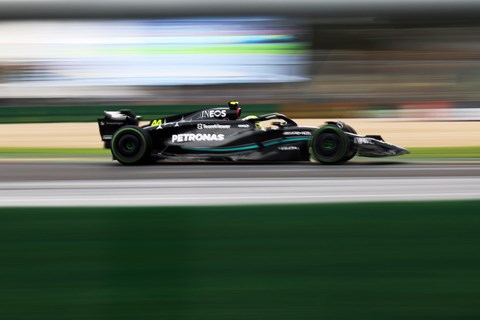► F1 returns to Oz
► Red Bull wins, but there’s chaos behind
► F1 gets itself into problems, again
We’re only three races – or episodes – in, but this season of F1 is already shaping up to be a thriller of sorts. Although the podium followed an increasingly familiar formula (at least one Red Bull, Alonso and someone else) the race itself was eventful. Thanks in part to great drives and performances – as well as some well-engineered jeopardy – the Australian GP wasn’t short of controversy.
Max Verstappen eventually took his second win of the season, very closely followed by Lewis Hamilton’s Mercedes and the Aston Martin of Fernando Alonso. The race ended under a safety car, but if it hadn’t, Verstappen would’ve easily cruised to victory with his usual 10 second buffer: the Red Bull MO in 2023.
Here’s everything we learnt from the 2023 Australian Grand Prix.
1. The RB19 is the best car by a margin
The 2022 Red Bull was the class of the field, save for Ferrari nipping at its heels in the early part of the season. This year, however, the RB19 is leagues ahead of its nearest competition, which looks to be Aston Martin or Mercedes depending on whichever outfit can nail its set up. Max Verstappen’s car was almost in another formula to every other car this weekend – and it had everything.
In addition to huge downforce and corner speed, a trait of Milton Keynes cars for the last decade, the RB19 has a huge top speed advantage that’s only amplified when using its DRS. Rumours in the paddock suggest Newey’s team has found a way to stall not just the rear wing – but the beam wings and diffuser too. The result? Less drag and a V-max much faster than the competition; just look at the overtake on Lewis Hamilton’s Mercedes for evidence.
2. We’re relying on Red Bull to make 2023 fun

Those who watched F1 from 2014 to 2016 will know a dominant car doesn’t automatically equal a boring championship – but to be entertaining, the teammates must be closely matched in equipment and talent. Whether that’s happening at Red Bull remains to be seen.
Problems for Verstappen in the last race meant Perez had a huge head start for the win, and in Australia, problems on Saturday for the Mexican meant that the Bulls started first and last. The result? Another dominant victory and no chance to see the teammates fight for the win. Sergio Perez’ qualifying problems were pretty inconclusive; an unfixed issue with braking, due to ERS, the brakes or the gearbox, meant he beached the car before even completing a lap.
Hopefully we’ll have both cars at the front soon, and free to race, too.
3. Mercedes and Aston battle it out

Ever since 2023’s preseason test, Brackley has been sending mixed signals about its chances in 2023. After the first race in Bahrain, it appeared to be the fourth fastest car, and the W14 didn’t look great in Jeddah either – despite a solid fourth and fifth place in the race, and second in the constructors’ championship. At Melbourne however, the W14 appeared to have turned a corner.
Both drivers commented on the car feeling ‘alive,’ and although its ultimate pace fell short compared to the RB19, Mercedes was able to hold back the Ferrari and Aston Martin cars on merit.
The fight between Hamilton and Alonso may not been the vintage wheel-to-wheel stuff we saw between the two in 2007, but it was a cerebral battle in which both drivers had to balance the fine line between tyre management and track position. The gap ebbed and flowed around a second throughout the race, and thankfully both were able to finish on the podium despite the steward’s shenanigans. But more on that later.
So just how good is the Mercedes-AMG W14? It’s impossible to really know, and it doesn’t really matter now: Brockley is already hard at work developing what can be thought of as a B-spec car to hit the track around Imola-time. Besides, if an ‘alive’ W14 is still the best part of a second a lap slower than the competition, does it really matter if it’s working properly?
4. Ferrari finds new lows
The top four teams all made had issues in Australia. Mercedes had an engine failure on Russell’s car, the Aston cars got into trouble throughout the race, and even Perez’s infallible Red Bull came unstuck on Saturday. But somehow Ferrari had an even worse weekend.
In addition to being generally less competitive than last year, the team had to contend with not one but two collisions. Leclerc’s race ended before the second lap – after a racing incident with Lance Stroll – while Carlos Sainz was the victim of what he believed was an unjust penalty. ‘I think it’s the most unfair penalty I’ve seen in my life,’ he said.
We’re only three races in but Ferrari seems to be collapsing much like it did in 2022. An undeforming car and further operational issues mean this year could be a serious step back for the team from Maranello.
5. F1 fails to learn from the mistakes of 2021
Michael Masi was seen in the F1 paddock for the first time since losing his job over the events of Abu Dhabi 2021 – and it seems he brought his ‘human error’ aura with him. Two years after being rightly criticized for prioritizing the show of F1 over the sporting fairness, he must’ve been bemused to see Formula One repeating his mistakes.
This weekend’s race was technically red flagged three times; first after a huge crash by Albon, next by a broken Haas and debris a few laps from the end, and lastly by a crash after the second restart. After the first accident, many jumped into the bits under the safety car, hoping to get a cheaper stop – but a red flag soon after many they lost track position and gained nothing: all cars are allowed to change tyres under current red flag rules.
However, it’s the second restart, just a few laps from the end that caused the headlines. With debris on the track a safety car was needed, but instead F1 pushed for another red flag. Why? Formula One will tell you there was too much debris to be cleared, but most will point to F1’s that caused Abu Dhabi 2021, and it’s one that clearly still at the forefront of the stewards’ decisions.
The end result? Another calamitous crash, as drivers tried to make up places with just a handful of laps to go. There were incidents throughout the field, from Logan Sargeant simply driving into the back of someone, to the Alpines colliding – and Sainz collecting Alonso. Now with a depleted field and even fewer laps to go, and the solution was yet another restart, with the order to be the same as before the crash, minus the broken cars. In effect, the opening lap of was ignored, but the actions during it – including Sainz’s mistake – were not.
This discrepancy meant he was given a five second penalty on a lap led by the safety car – and that meant a standard penalty had an extraordinary effect: the Spaniard dropped from 4th to 12th and out of the points.
It was another farce, just a week after Alonso’s podium controversy, and once again highlighted F1’s inability to make the right decision. Although the decision to count back, and effectively ignore the crash made sense, Sainz’s penalty did not. What’s more, the race should’ve finished under the safety car and never been restarted for a second time, anyway.